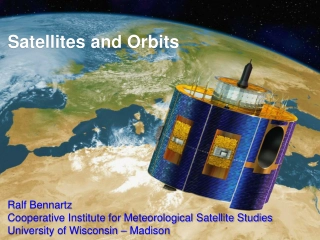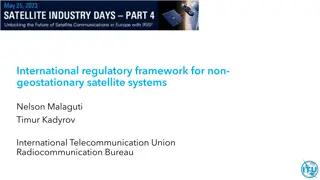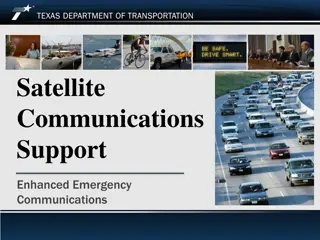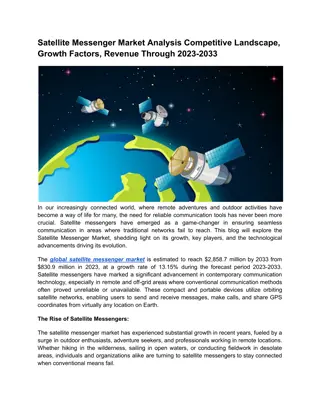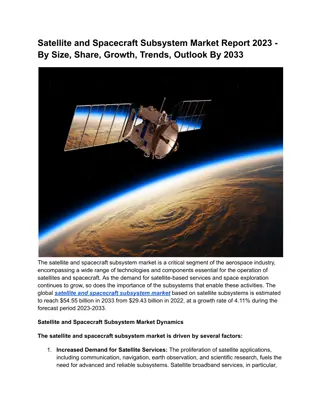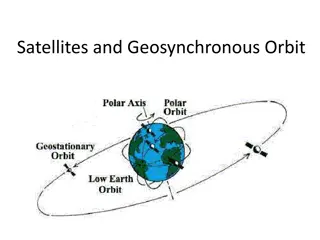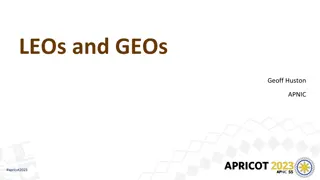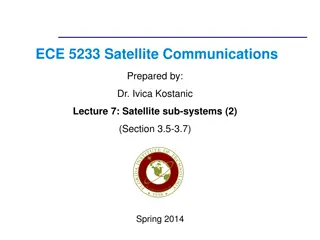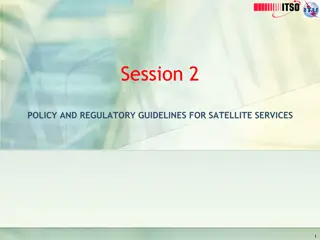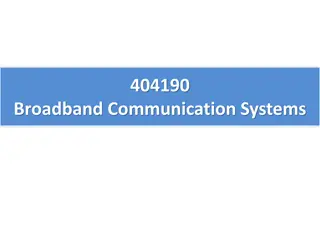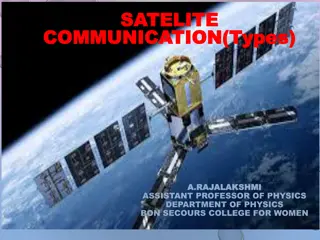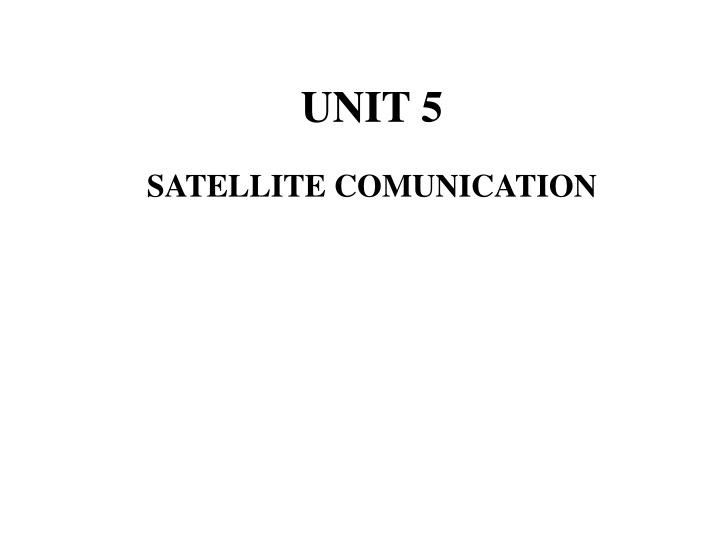
Satellite Communication: Orbits, Types, and Frequency Bands
Explore satellite communication orbits, types of satellites, frequency bands, and multiple access techniques like FDMA, TDMA, CDMA, and SDMA. Learn about geostationary orbits, low Earth orbit (LEO), and elliptical orbits used in satellite communications.
Download Presentation

Please find below an Image/Link to download the presentation.
The content on the website is provided AS IS for your information and personal use only. It may not be sold, licensed, or shared on other websites without obtaining consent from the author. If you encounter any issues during the download, it is possible that the publisher has removed the file from their server.
You are allowed to download the files provided on this website for personal or commercial use, subject to the condition that they are used lawfully. All files are the property of their respective owners.
The content on the website is provided AS IS for your information and personal use only. It may not be sold, licensed, or shared on other websites without obtaining consent from the author.
E N D
Presentation Transcript
UNIT 5 SATELLITE COMUNICATION
Satellite Communication: Orbits- types of satellites Frequency bands Multiple Access techniques: FDMA TDMA CDMA SDMA INTELSAT and INSAT.
Orbits When a satellite is launched, it is placed in orbit around the Earth. The Earth's gravity holds the satellite in a certain path as it goes around the Earth, and that path is called an "orbit.
Geostationary Orbit The most common orbit used for satellite communications is the geostationary orbit (GEO). This is the orbit described above the rotational period is equal to that of the Earth. The orbit has zero inclination so is an equatorial orbit ( located directly above the equator )
Low Earth Orbit/Medium Earth Orbit A Low Earth Orbit (LEO), or Medium Earth Orbit (MEO) describes a satellite which circles close to the Earth. Generally, LEOs have altitudes of around 300 1000 km with low inclination angles, and MEOs have altitudes of around 10,000 km.
Satellites that observe our planet such as remote sensing and weather satellites often travel in a highly inclined LEO so they can capture detailed images of the Earth's surface due to their closeness to Earth.
Elliptical Orbits A satellite in elliptical orbit follows an oval- shaped path. One part of the orbit is closest to the centre of Earth (perigee) and another part is farthest away (apogee). A satellite in this type of orbit generally has an inclination angle of 64 degrees and takes about 12 hours to circle the planet.
This type of orbit covers regions of high latitude for a large fraction of its orbital period.
Types of satellites Astronomical satellites are satellites used for observation of distant planets, galaxies, and other outer space objects Biosatellites are satellites designed to carry living organisms, generally for scientific experimentation.
Communication satellites stationed in of telecommunications. Modern communications satellites typically use geosynchronous orbits or Low Earth orbits are satellites the purpose space for orbits, Molniya
Earth observation satellites are satellites intended for non-military as environmental monitoring, meteorology, ma p making Navigational satellites are satellites which use radio time signals transmitted to enable mobile receivers on the ground to determine their exact location uses such
Killer satellites are satellites that are designed to destroy enemy warheads, satellites, and other space assets. Crewed spacecraft (spaceships) are large satellites able to put humans into (and beyond) an orbit, and return them to Earth. Spacecraft including spaceplanes of reusable systems have major propulsion or landing facilities.
Miniaturized satellites unusually low masses and small sizes. New classifications are used to categorize these satellites: minisatellite (500 1000 kg), microsatellite (below 100 kg), nanosatellite (below 10 kg) are satellites of
Reconnaissance observation satellite for military or intelligence applications. Very little is known about the full power of these satellites, as governments who operate them usually keep information pertaining to their reconnaissance satellites classified. satellites or are Earth satellite communications deployed
Recovery satellites are satellites that provide a recovery of reconnaissance, biological, space- production and other payloads from orbit to Earth. Space-based solar power proposed satellites that would collect energy from sunlight and transmit it for use on Earth or other places. satellites are
Space stations are artificial orbital structures that are designed for human beings to live on in outer space. A space station is distinguished from other crewed spacecraft by its lack of major propulsion or landing facilities. Space stations are designed for medium-term living in orbit, for periods of weeks, months, or even years
Tether satellites are satellites which are connected to another satellite by a thin cable called a tether. Weather satellites are primarily used to monitor Earth's weather and climate.
L-band (12 GHz) Global Positioning System (GPS) carriers and also satellite mobile phones, such as Iridium; Inmarsat providing communications at sea, land and air; World Space satellite radio. S-band (2 4 GHz) Weather radar, surface ship radar, and some communications satellites, especially those of NASA
C-band (48 GHz) Primarily used for satellite communications, for full-time satellite TV networks or raw satellite feeds. X-band (8 12 GHz) Primarily used by the military.
Ku-band (1218 GHz) Used for satellite communications. In Europe, Ku-band downlink is used from 10.7 GHz to 12.75 GHz for direct broadcast satellite services Ka-band (26 40 GHz) Communications satellites, uplink in either the 27.5 GHz and 31 GHz bands, and high-resolution, close-range targeting radars on military aircraft.
Multiple Access techniques Sometimes a satellite s service is present at a particular location on the earth station and sometimes it is not present. That means, a satellite may have different service stations of its own located at different places on the earth. They send carrier signal for the satellite.
In this situation, we do multiple access to enable satellite to take or give signals from different stations at time without any interference between them. Following are the three types of multiple access techniques. 1. FDMA (Frequency Division Multiple Access) 2. TDMA (Time Division Multiple Access) 3. CDMA (Code Division Multiple Access)
FDMA (Frequency Division Multiple Access) In this type of multiple access, we assign each signal a different type of frequency band (range). So, any two signals should not have same type of frequency range. Hence, there won t be any interference between them, even if we send those signals in one channel
Example Radio channels We can see that each station has been given a different frequency band in order to operate.
Station A has been kept under the frequency range of 0 to 20 HZ. Stations B have been assigned the frequency range of 30-60 Hz Stations C 70-90 Hz respectively. There is no interference between them
Disadvantages: This type of multiple access is not recommended for the channels, which are of dynamic and uneven. Because, it will make their data as inflexible and inefficient.
TDMA (Time Division Multiple Access TDMA is a time based access. Here, we give certain time frame to each channel. Within that time frame, the channel can access the entire spectrum bandwidth. Each station got a fixed length or slot. The slots, which are unused will remain in idle stage.
packets 1, 3 and 4 are active, which transmits data. packets 2 and 5 are idle because of their non- participation. This format gets repeated every time we assign bandwidth to that particular channel.
Suppose, we want to send five packets of data to a particular channel in TDMA technique. So, we should assign them certain time slots or time frame within which it can access the entire bandwidth.
We have assigned certain time slots to a particular channel but it can also be changed depending upon the load bearing capacity. That means, if a channel is transmitting heavier loads, then it can be assigned a bigger time slot than the channel which is transmitting lighter loads. This is the biggest advantage of TDMA over FDMA
Advantages .Another advantage of TDMA is that the power consumption will be very low.
Combination of FDMA and TDMA In the FDMA techniques. In this case, each channel will be operated in a particular frequency band for a particular time frame. In this case, the frequency selection is more robust and it has greater capacity over time compression. some combination applications, of both we use TDMA and
CDMA (Code Division Multiple Access) In CDMA technique, a unique code has been assigned to each channel to distinguish from each other. A perfect example of this type of multiple access is our cellular system. We can see that no two persons mobile number match with each other although they are same X or Y mobile service providing company s customers using the same bandwidth.
Encoded signal = Original data chipping sequence In CDMA process, we do the decoding of inner product of the encoded signal and chipping sequence.
Advantages It allows all users to coexist and use the entire bandwidth at the same time. Since each user has different code, there won t be any interference. The best part of this technique is that each station can use the entire spectrum at all time.
Space-division multiple access (SDMA) Space-division multiple access a channel access method based on creating parallel spatial pipes (focused signal beams) using advanced antenna technology next to higher capacity pipes through spatial multiplexing and/or diversity, by which it is able to offer superior performance in radio communication systems (where multiple users may need to use the communication media simultaneously). (SDMA) is multiple access
In traditional mobile cellular network systems, the base station has no information on the position of the mobile units within the cell and radiates the signal in all directions within the cell in order to provide radio coverage. This method results in wasting power on transmissions when there are no mobile units to reach, in addition to causing interference for adjacent cells using the same frequency, so called co-channel cells. Likewise, in reception, the antenna receives signals coming from all directions including noise and interference signals.
Definition of 'Intelsat' By using smart antenna technology and differing spatial locations of mobile units within the cell, space-division multiple access techniques offer attractive performance enhancements. The radiation pattern of the base station, both in transmission and reception, is adapted to each user to obtain highest gain in the direction of that user. This is often array techniques. done using phased
Definition: Intelsat, S.A. is a leading provider of communication satellite services. Intelsat was originally formed as the International Telecommunications Satellite Organization (INTELSAT).
From intergovernmental conglomerate that owned and managed a group of communication satellites that provided broadcast services. Intelsat currently operates a fleet of 52 communication satellites - one of the largest fleet organization as of March 2011 1964 to 2001 it was an international maintained by any
` Description: The IGO, or intergovernmental organization, began with a group of 11 participant countries on 20 August 1964. Intelsat s first major satellite, namely the INTELSAT I, was placed in the geostationary orbit by a Delta D rocket. The geostationary orbit was above the Atlantic Ocean.
The name of the IGO was changed in the year 1973 and thereafter it had 80 signatories. The organisation provides communications services to around 150 countries and over 600 Earth stations. The intergovernmental organisation had around 100 members by 2001. In the same year, INTELSAT was privatized and its name was changed to Intelsat.
The number of Intelsat satellites and ocean- spanning fiber-optic lines allow fast and immediate re-routing of traffic in case one of the satellites fails. New satellites made with modern technology are more robust and last longer since they have larger capacity.
The corporate headquarters of Intelsat is located in Luxembourg and contains majority of the staff and satellite functions. The administrative headquarters in Washington, DC with other Intelsat corporation offices are also located there.

